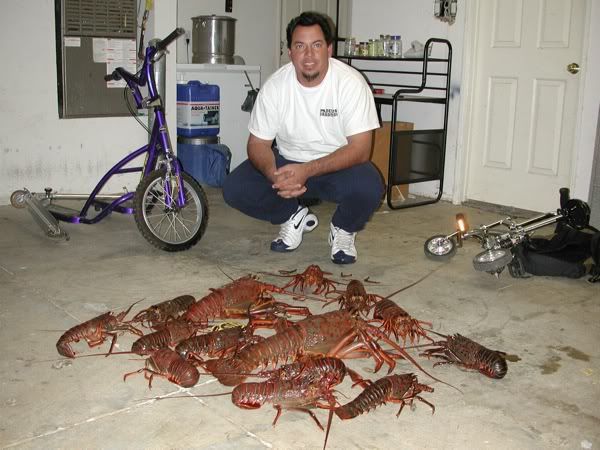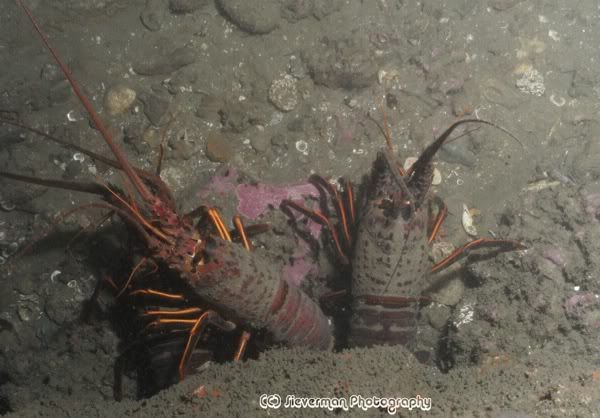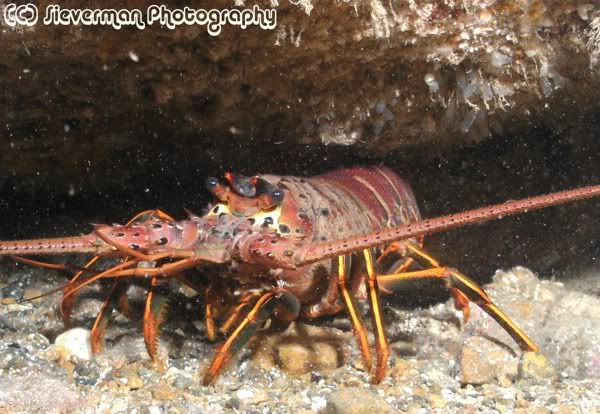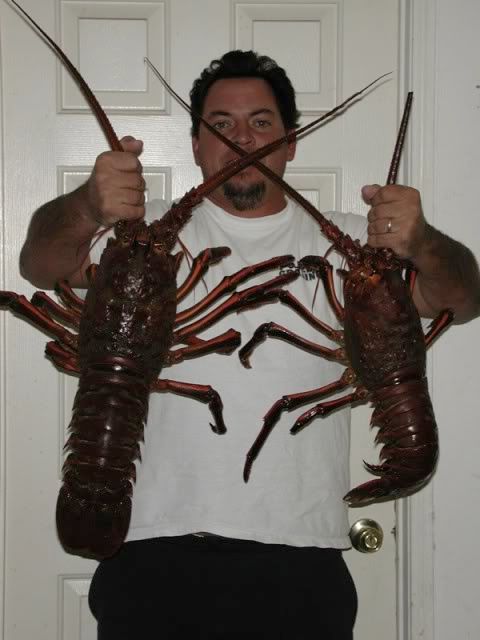If you’re one of the 6 billion-or-so humans who hasn’t visited another planet, it’d almost take a sci-fi writer’s imagination to envision what it’s like to be near zero-gee, inches above a surface that’s part waving grassland and part sand interspersed with mysterious crags and crevices, slowly progressing through pitch black darkness—on a hunt for bugs.
Round, beady little eyeballs stare up at you. Crazy looking antennae twitch. The little, elusive beastie darts quicker than you’d imagine into a small cave. Adventurous hunters hover upside down and stick their heads in the cave, followed quickly by a gloved hand, to snatch the bug, if they can.
Bugging season, as lobster hunters like to call it, has arrived. With a little preparation and training, nightly adventurers wander into otherworldly environs off the coast in search of the California spiny lobster. Lobster season started Oct. 3, and ends on March 17. While it may sound like a sport reserved for the extreme types, lobster hunting doesn’t demand a great deal of daring or peak athletic fitness. But it does require a little training if you are new to the sport and scuba diving.
To be a bug hunter, or any kind of underwater hunter (spear fishing is also a popular Southern California scuba sport) one might consider becoming a certified diver, and getting certified to dive at night—a night diver specialty course or an advanced open water diver certification will do. These are general guidelines handed down by scuba organizations, like the Professional Association of Diving Instructors or the National Association of Underwater Instructors.
A few weeks ago I decided to spend my birthday finishing off my advanced open water diver certification with a nighttime dive, the last of five required dives for that level of proficiency. I was first introduced to scuba diving last April in Jamaica, when I paid $100 for a Discover Scuba Diving experience—some local diving shops offer the introductory program for free. Thanks to lax standards on the island, the “experience” consisted of a brief stint in a pool learning to breathe through a regulator before plunging into the warm waters of the Caribbean for a pair of dives down to about 40 feet.
A few months after my trip, I attended the annual Scuba Show at the Long Beach Convention Center, where I learned it was fairly affordable to become a certified scuba diver. And soon after I visited the Sports Chalet at the Long Beach Towne Center and picked up some class schedules and planned my learning adventure.
Besides Sport Chalet there are several outfits in and around Long Beach that offer scuba classes, including Pacific Scuba Center near Belmont Shore’s Second Street, and New England Divers Inc. near the Long Beach Airport. Lobster hunting and scuba certification classes are offered regularly at those locations, including weekday evenings and weekend sessions.
A basic scuba certification typically costs around $400 for classes, which may include a boat trip out to Catalina Island, but you can shop around for less expensive programs that teach students via shore dives only. Lesson plans vary, but it generally takes about nine hours of pool time practicing some scuba basics, as well as some class time and a bit of studying, then four ocean dives to demonstrate certain skills. The advance diver program entails five ocean dives and some more book learning, but the knowledge and training received is well worth it. Taking an underwater hunting class is recommended, which not only teaches safety and environmentally sensitive techniques, but it can help hone your skills so that you can actually catch one of the lightning quick critters.
To bug hunt one must pay for a fishing license with an ocean enhancement stamp, as well as pay about $7 for a lobster report card, get a lobster gauge (minimum size is 3.25 in. on the midline of the back from the edge of the eye socket to the edge of the body shell, according Fish and Game) and a bag with which to hold the catch.
“There’s a technique and it takes practice,” says Lakewood resident Thomas Holmes, a scuba instructor who teaches Sports Chalet’s underwater hunting classes. “For one thing, lobsters are nocturnal. They come out and night and forage for food, which makes it difficult. And you need to know that the smaller the lobster the quicker they are. They just flip their tail and shoot backward. Grabbing them by the tail is one technique, but you have to be careful if you reach into holes for them, as it’s very common for eels to be in the same holes as lobster.”
The eel I saw during my night dive at Laguna Beach’s Wood’s Cove was pretty fierce looking, so heed Holmes’ advice.
Avid bug hunter and underwater photographer Mike Sieverman, a retired Signal Hill police officer who often dives and takes photos for New England Divers, states: “It’s about as level a playing field as the creatures get, we’re in their environment, breathing from a tank, unable to see without lights, so the odds are in their favor. When they come out to feed at night, they are typically in the open, and, if you’re quick enough, can be grabbed up and stuffed into a bag.”
Wood’s has a tricky beach entry and exit that requires one to wade through a small strip of sand between rocks. Once in and under, eelgrass combined with a bit of underwater surge, which presents added challenge on a night dive, can be pretty disorienting immediately after you first drop down. Once you’ve got your bearings, numerous man-sized cracks run through the reef at the bottom in which one can navigate inside of and explore, each side offering abundant nooks sheltering ocean life.
And if you didn’t get it when I first wrote it, the blackness is incredible. Picture shining a small pen light in a dark closet: whatever you shine the light on is illuminated, and everything a few feet away in your peripheral vision is about as black as space. Once you’ve learned to deal with the deceptive effects of waving eelgrass, which causes the brain to believe it is really you who is moving, and you settle into the darkness, the wanders of night diving unfold.
Many long time lobster divers like Sieverman practice and preach environmentally responsible hunting. “I truly believe that sustainable fishing, and conservation begins with the individual. Commercial fishing has devastated our local sea life, but so has the private sector,” Sieverman states. “One only has to look at photos from the early 1900’s and see how many fish were caught and killed for no other reason than a postcard. That lack of responsible management has gotten us into this mess, and now with the changes proposed by the Marine Life Protection Act, the plans to reduce fishing even more makes most hardcore fisherman upset, but if we don’t do something now, who will? What kind of world are we leaving our grandchildren?”
Sieverman, who lobster dives once or twice a month, limits himself to well under the legal limit, and he’s conscious of size, keeping “well above the minimum, but I do not take the large older lobsters, who are our breeding stock. In California, divers are only allowed to use their bare (or gloved) hands to take lobster, no tools other than a light may be used. Does this mean that all divers are abiding by this? No, no they’re not. Sticks, nets poles and other devices are used. I’ve also seen lobster taken out of season.”
And there’s a running joke among scofflaws, he notes: “What’s my favorite way to eat lobster? Poached.”
By the end of my night dive, among the spotted creatures were about half-a-dozen lobster, none large enough for any of the hunters out that evening to keep, and several species of fish and eels. The experience was draining, and getting some Earth back under my feet was a treat—though the long trek up a seemingly endless flight of stairs with a scuba tank on my back, about 27 pounds in weights, and a water-logged wetsuit, was tiring to say the least. Gravity can be a bugger sometimes.
Photos courtesy Mike Sieverman





BUGGING LOWDOWN
Essentials
Multimedia
http://video.google.com/videoplay?docid=-1206655694253143834&hl=en#
Regulations
